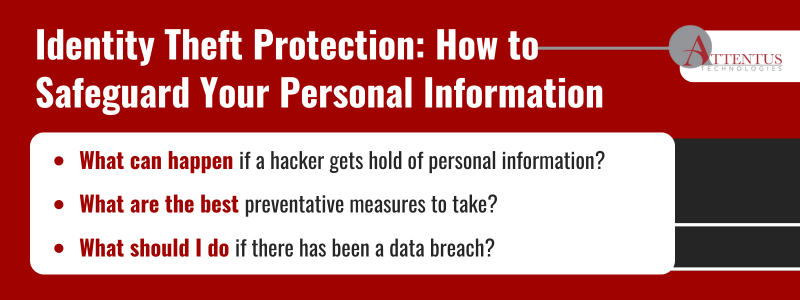Consumers and companies need to find effective ways to safeguard personal information that hackers can abuse
Identity theft is an escalating threat to consumers and organizations handling sensitive data. When personal or financial information is stolen, it can be used to commit fraud, such as unauthorized purchases or applying for credit cards and loans using a stolen Social Security number.
The results can be a loss of money and credit standing. Companies that experience major data breaches can also suffer damage to their reputation and expose themselves to legal action.
So whether personal information or sensitive data is stolen through phishing scams, vishing, smishing, social engineering, fake websites, impersonation schemes, or other means, individuals and companies must take the right preventative measures for identity theft.
You can achieve security and peace of mind by implementing fraud protection measures and correct cyber hygiene practices.
The importance of identity theft protection
Statistics show that Americans have suffered as much as $8 billion a year due to identity theft. Among individuals, many of those polled lost $100 to $150, and a significant number reported losses of more than $1,000.
Data breaches have also had serious consequences for large organizations. For example, in 2023, HCA Healthcare suffered a data breach, compromising the personal information of some 11 million patients, including their names, dates of birth, email, and telephone numbers.
Individual victims and compromised businesses often hadn’t taken adequate identity theft precautions.
Fraud alert setup
One of the basic and best ways to protect yourself from identity theft is to set up a fraud alert with a credit bureau, such as Experian, Equifax, or TransUnion. If a creditor checking your report sees the flag for a fraud alert, they must confirm your identity before issuing credit in your name.
If you have a fraud alert initiation on your account, you must renew it yearly. Extended fraud alerts last seven years and are usually obtained by people who have already been victims of identity theft.
Monitoring credit activities
Bureaus offer credit monitoring services to help you monitor your credit status year-round. Credit monitoring and alerts help you respond quickly to identify theft by alerting you to suspicious activities, such as applying to take out a loan or opening a bank account in your name.
Being proactive and acting right away is important because it helps you avoid the headaches of trying to restore your identity after it has been compromised.
Two-factor authentication
Using two-factor authentication or dual-factor verification can make it much more difficult for a cyberattacker to gain access to your online accounts, information, or devices. This method of identity verification offers far more security than single-factor verification, which might only involve a password.
By setting up two-factor authentication, you get enhanced account security measures. The first factor might be a password or passcode, and the second could be a security token, a fingerprint or eye biometric scan, or even a confirmation message sent to a predetermined text number or email address.
Even greater security may be coming down the road with three-factor authentication.
Account recovery steps
You must undertake some account recovery procedures if you are an identity theft victim. So if, for example, you’ve had your social security number stolen and used to open a new credit card account, you should file an identity theft report with the FTC and also report the crime to your local police department. The FTC will provide a recovery plan according to the information you’ve left on the online questionnaire.
You should also notify the three major credit bureaus of the problem and ask them to issue a fraud alert or credit freeze to stop any more unauthorized use of your information. You can also dispute any unauthorized activity with the bureaus so you can repair any damage to your credit rating. You should also contact any financial companies or accounts affected by the fraud, perhaps disputing credit charges, freezing accounts, disputing bogus charges, and taking other measures.
You should act quickly to rectify the situation so that other “bad actors” don’t use the same information for unauthorized activities.
Cybersecurity best practices for organizations
On a business level, it is important to take the right cybersecurity measures to protect sensitive data. Organizations often store a treasure trove of personal data, making them attractive targets for cybercriminals.
One important way to avoid stolen confidential information, financial losses, and regulatory problems is to adopt best practices in cybersecurity, such as:
- Keeping software and hardware up to date
- Training employees to not open suspicious emails and take other precautions
- Implementing anti-virus and malware removal programs
- Scanning external storage devices for viruses
- Advising remote workers not to use public Wi-Fi networks
- Backing up all important data
- Using effective passwords
Data breach responses
Whether through malware, a DDoS (distributed denial of service) attack, or a physical breach, data breaches must be met with an effective response to quickly contain the problem and minimize damage.
Some of the ways to prevent and deal effectively with major data breaches include:
- Ongoing monitoring of networks
- Regular data backups
- Timely system updates
- Keeping up to date with the latest cybersecurity threats
- Training staff in cybersecurity awareness and measures
Identity theft prevention tips
Ultimately, consumers and businesses can best protect themselves by learning about potential identity theft schemes. They should also take practical steps to keep personal information secure, such as:
- Storing sensitive personal information in a secure place
- Making it a habit not to share sensitive information over the phone or the Internet unless you initiated the contact or the other party is a trusted contact
- Using strong and different passwords for each account
- Continuously monitoring your bank and credit accounts and credit reports
- Using only one credit card for online purchases (and not a debit card)
- Disposing of old computers and mobile devices safely
The best way to protect sensitive information
Consumers who want to protect themselves from identity theft need to learn more about the means cyber attackers use to access their information and implement practical defense measures, such as strong passwords for accounts, fraud alerts, credit monitoring with credit bureaus, and two-factor authentication.
For businesses looking to protect their most sensitive information, partnering with a managed services provider (MSP) like Attentus Technologies offers peace of mind. With over 20 years of experience in cybersecurity, we’ve earned the trust of our clients by safeguarding their most critical data. Our cutting-edge cybersecurity solutions, 24/7 network monitoring, and reliable data backup and recovery services ensure that your information remains secure, no matter the threat.
Contact us for a free assessment to find out how we can help you safeguard your data.



